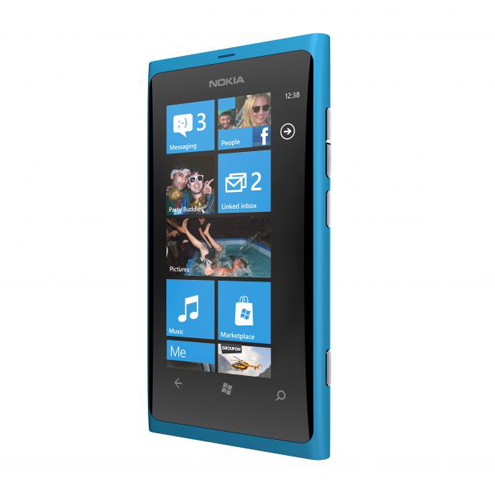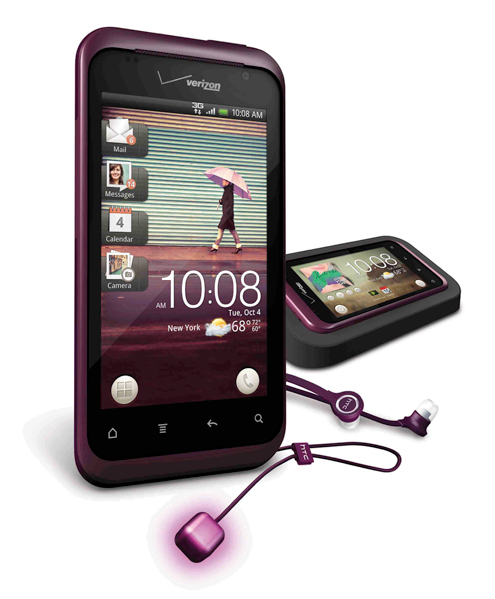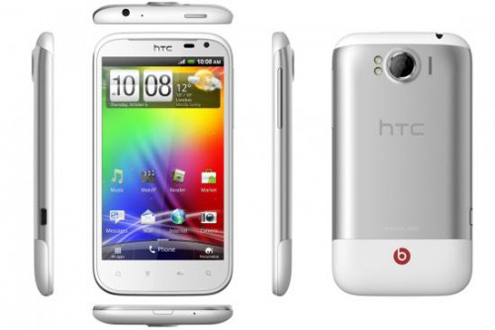For some weeks now my jacket pockets have been bulging in an unsightly manner as I have gone about the world with a BlackBerry Bold 9900, two HTC Android handsets, the “Rhyme” and the “Sensation XL with Beats Audio” and the all new Nokia Lumia 800 running Windows for Mobiles 7.5 “Mango”.

What’s the smartphone world up to at the moment? Well, mostly we have had to witness the sorry spectacle of patent suits and counter-suits between Samsung, HTC, Apple, Google, Nokia – in fact all the big players in the game, each of them shelling out huge sums in lawyers’ fees for cases where they are fighting each other or those creepy companies who have invented and given the world nothing but stealthily bought up patents over the years and now hope to rake in many tens of millions. By way of retaliation and to prevent more of this, a consortium consisting of some of the biggest beasts in the jungle – Apple, Microsoft and BlackBerry maker Research in Motion amongst others – paid four and half billion dollars for Nortel, while Google splashed out even more impressively, paying twelve and half billion for Motorola Mobility and its 17,000 patents. Yes, 17,000. How many patent lawyers charging how much an hour will it take to work through that portfolio? The mind boggles.
Do we remember any of this happening in the auto industry? Does whoever came up with the limited slip differential get a licence from every car that uses one? Or the inventor of fuel injection, the overhead camshaft or the wishbone chassis? Did it happen in the manufacture of radio and television sets? Maybe it did but we just didn’t know about it. To the outsider the current situation resembles nothing so much the bloodiest kind of shark feeding-frenzy.
Large corporations can at least look after themselves. The problem is that smaller, ever creepier parasitic corporations, “patent trolls”, have been currently making life hell for individual third-party app developers too, bombing them with Cease and Desist letters asserting that the app they have designed has used, probably in all innocence, some algorithm, routine or in-app purchasing technique that has been sneakily hoarded by the company – an algorithm, routine or technique that would certainly have been independently invented by hundreds of different app developers anyway. Earlier this year it seems that in the case of the most notorious of these companies, Lodsys, Apple stepped in on behalf of the developers
Well it’s not an area I have any expertise in, but it does leave a nasty taste in the mouth. Of course original creations and inventions should be protected, but as with the case of musical copyright I would argue (as I did here at the iTunes Festival in London in July 2009, the periods of greatest creativity have been those where weak copyright has prevailed. It is, to (mis)quote, the fencing master in Scaramouche, like holding a bird. Clutch too tight and you will crush it, too loose and – pah! – she will fly away.
Anyway, while all this goes on, the multi-billion dollar business of trying to get you to buy into a smartphone continues apace. There are, I’m sure I don’t need to remind you, four big players here. RIM, who make the BlackBerry that once dominated the business world almost entirely, Apple, whose iPhone utterly transformed the idea of what a smartphone could be, the Google Android Open Handset Alliance which was (cough) inspired by Apple to produce their own not strikingly dissimilar operating system and finally, last year, Microsoft, who threw their hat in the ring with Windows Mobile 7, now called just plain Windows Phone.
They all take apps, they all can play YouTube films, but only the Android devices have Adobe Flash – and most Androiders will try and avoid using it very much. Everything Apple said about it when Steve Jobs declared the iPhone would never carry it has turned out to be true and Adobe themselves have finally come to realise this and to accept the inevitability of HTML 5 constituting the proper way forward.
There is a core of must-have productivity apps these days that is beginning to dominate: every operating system has its version of Kindle and Evernote for example, or Dropbox (in the case of Windows Mobile only a free client app at the moment) – the latter two cloud-based utilities allow users to ensure that the files they create on their laptop or desktop are also available on their tablet or smartphone. And vice versa. If you get me. Plenty of security or photo utilities like 1Password or DropImage for example, are beginning to get a similar kind of traction, by being Dropbox savvy.
So in the end, what I suppose I am trying to say is that these phones I have been using are all converging somewhat. I find I am using email clients on all them that are intelligently plugged into Gmail and allow me to do anything in terms of archiving and drafting that I could do with a desktop app like Sparrow or by Gmailing on the web. I use Dropbox on all the devices, and I use Kindle and Evernote too. Each system has its official Twitter app and a variety of third-party options available through their App Store, Market, Marketplace, App World or whatever they might choose to call it.
Little arms races take place between the systems: Apple released the iPhone 4S complete with built in voice recognition for every app that uses a keyboard, as well as the much feted, mocked, loved, tolerated, abused, seduced and shown-off Siri, “your personal assistant”. Just yesterday an Android equivalent Cluzee was announced (who dreams up these names? Are they paid? No, I mean in actual money. Really?).
New ways of integrating GPS, mapping and intelligent shopping, parking, sight-seeing, navigating and trekking come along all the time, but to be perfectly frank things have got to the stage where each of the four systems can be said to offer broadly the same functions and capabilities. Which leaves us, as it always did, with the question of preference. Which experience is most satisfying, most fun, most reliable and most desirable? Or to put it another way, which is the least fiddly, the least flaky and the least intuitive? I can’t claim to have a definitive answer for that. It would be like telling you which breed of dog is best. Opinion, emotional attachment, aesthetics, social pressure and cost will always come into play quite as much as functionality.
We live in hard times and these gismos are not cheap. Your network operators offer upgrade paths that may seem slow to those who want the newest phone now, but it is worth either phoning up or going in to your local store and turning on the charm. One hears stories of some lucky people getting upgraded because the assistant they spoke to seemed to be in a good mood while others whose accounts were identical have been met with nothing but blank indifference.
So to the devices themselves.


Recent news has been bad, very bad, for RIM. I have tried to like their terribly flawed Playbook tablet, but failed to find it had any part to play in my life. I have always thought their original Bold handset was as perfect in its day as a phone could be, and was pleased that after the catastrophe of the Storm and the ho-hum of the Torch they finally produced a month or two ago their Bold 9900, a phone that seamlessly blends touchscreen and keyboard capabilities in a totally satisfying way. If you are a happy BlackBerry fan this will be the phone that you want. Battery life used to be the BB’s great selling point when compared to power-hungry rivals, but what with the way apps use 3G and Wi-Fi and mapping and GPS and Bluetooth, you can easily find yourself out of juice half way through the afternoon if you’ve been hitting the phone hard. But this is true of all the devices under consideration. Blackberry, like the HTC devices, can at least offer removable batteries. The new Bold is also one of the first to offer “Near Field Communication”, a standard yet to be widely implemented that will allow the phone to activate other devices close to it, such as smartpay machines and, of course, other phones or computers.
In the wider corporate context, the world of Enterprise which has been the bedrock of BlackBerry’s business success has been slowly slipping away from RIM. As a result they announced only yesterday that they will be allowing their Enterprise Management Suite to work with other platforms. A sign of weakness, but also a recognition of the inevitable, as most commentators have agreed. This move may allow them to stay in the game, even if they will never again be quite the force they once were.
The two HTC phones I’ve been playing with reveal the startling turn around rate that goes on in Taiwan, where HTC are based. They seem to bring out new Android and Windows phones four times a year. It is getting very hard to tell which kind of Desire or Sensation you have and what the difference between them is. The Sensation XL With Beats, is as big a phone as I’ve seen in a long while. For all its size, the 4.7” LCD screen doesn’t excite with colour richness in quite the way that the AMOLED displays of many rivals do, I’m thinking of the Samsung Galaxy for example. There’s an 8 megapixel camera, all the HTC Sense scenes and widgets and pages full of the useful free bundled software that Android users have come to expect. There’s a video store called Watch which has a reasonable selection of films for downloading and, most importantly of all, there are the Beats that give the device its strange name. You will probably be aware of Dr Dre and his Beats earphones; well, a pair of these come with the Sensation XL and baked in is his personally tweaked “Beats Audio Technology”. I have absolutely no interest in such things to be honest. The sound appeared to be excellent, but maybe it suits someone with a different kind of music collection. I don’t suppose the hip-hop legend had Wagner and Glenn Gould in mind when tweaking the audio for HTC. With a single core 1.5GHz and 768MB or RAM such a large phone seems significantly underpowered. And when the next flavour of Android comes out (mine is running Gingerbread 2.3.5) it will be a question as to whether this behemoth will be up to the task of coping with whatever demands Honeycomb and Icecream Sandwich make of it (in case you wonder what I’m drivelling about, Android name each full new release after a cake, ice-cream or pudding. We started with Cupcake, Donut and Éclair who knows where we’ll go after Honeycomb).

So, not a bad phone, but not a great one. Its slightly smaller sister, the dual core Sensation SE seems a more sensible solution to me, a very similar device but with just a bit more oomph.
Compared to either the Rhyme seems absolutely tiny, although in truth it is about the size of an iPhone. I can’t quite make the Rhyme out. It has two new hardware features; one is a docking station that turns it into a beautiful alarm clock if you locate it on your bedside table. The other is most extraordinary. It is a long string with a small white cube on one end and a mini-jack on the other. The idea is that when your phone is in your bag, you attach this “glowing purse charm” into your earphone socket and leave the white cube outside the bag. When the phone rings the cube glows and you can follow the string down into your bag and find your phone. Here’s a film if you can’t make sense of the way I’ve tried to explain it.

This accessory and the fact that the default colour of the phone is a lush kind of purple alerts us to the distressing truth. HTC is making a phone for women. Women are always fiddling about in their bags for their phones and so they need a “glowing purse charm” to help them out. At least, this is the implication: but let’s be frank, the sight of women diving into their bags trying to locate their phones is not so rare. Motorola didn’t do too badly with Razr devices aimed squarely at pink-loving, fun-loving ladies, and far be it from me to decry HTC’s attempt to attract a female following too. As a phone the Rhyme is not a stand-out. It is perfectly fine, it is, as are all Androids, especially those front-ended by HTC Sense, much more customisable and pimpable than rivals, so if you don’t like the default screen you can easily change it. Well, fairly easily – there is a shallow but undeniable learning curve and I have seen people throw their Androids across the room because they couldn’t work out how to get two clocks with two different time zones onto their home screen at once.
And so we come to the most important (in terms of corporate destinies at least) phone of all. The Nokia Lumia 800.
The story of Nokia’s rise from lumber, wellington boot and lavatory paper company to world domination of the mobile phone market is the stuff of legend (and admirably told here, should you be interested. The inexorable relaxation of their grip as Apple’s iPhone reshaped the world of mobile telephony has been a sad sight to behold. Their venerable Symbian operating system was a miracle of compactness, reliability and power economy and is still in use (and will continue to be) in fantastical numbers around the world. But their share price has slipped as their market share has fallen here in the west and grim prognostications were being made about the Finnish giant.
They bit the bullet last year and realised that they were going to have to play or leave the table. An alliance with Microsoft was announced. Here were two corporations who understood all too well the pain that comes when what seems like unassailable domination turns with such dizzying speed into a humiliating downward spiral. Neither had reached anything like rock bottom and they were cash rich enough to invest in their new partnership. The hope of each CEO, Stephen Elop of Nokia and Steve Ballmer of Microsoft, is that Nokia’s brand reputation as a reliable builder of phones and Microsoft’s reach and penetration as a software provider will allow the alliance to face up to Apple and Google and carve a share in this quite unbelievably valuable market. The stakes are very very high.
I was present at the launch of Microsoft’s Windows Mobile 7 last year. I liked what I saw and was happy to say so. There were many similarities with the release of the iPhone in 2007. No microSD slot, a GUI precisely governed by MS, at launch no cut and paste and naturally a very small choice in third party apps… but there was much to like. The smoothness and glide, the cleverly baked-in social networking elements, the (only to be expected) quality of MS Office and Xbox Live compatibility. LG, Samsung and HTC were the two major manufacturers for the OS then and they each did a good job.
And now Nokia has stepped in with two models, the Lumia 800 and 710. I haven’t had any experience of the latter, which is a more affordable version of the 800, with 8 GB of internal flash memory to the 800’s 16.
Now, Microsoft’s approach has been ever more “walled garden” than Apple’s, and Windows Phone devices are the least pimpable of all. You can change the colour of the signature tiles that make up the GUI, you can have a black background or a white background. You can certainly introduce wallpaper, but that is about it. Ringtone customisation has arrived and the app Marketplace is filling up with well designed version of old friends like Angry Birds and IMDB as well as the essentials like Evernote that I’ve already discussed.
So all I can do when I describe the Nokia is tell you that it is an elegant candybar (familiar to those who remember the N9) it has a very bright and likable AMOLED screen, a rear 8 megapixel camera (no front facing one) and the obligatory three touch screen buttons at the bottom: Back, Home Screen and Search.They have decided against the removable batteries found in HTC and Samsung Windows Phone devices.
Nokia have added their own goodies, Nokia Drive, Nokia Maps and Nokia Music. Nokia Drive is a turn-by-turn GPS navigation system (with selectable voices) which works extremely well and is certainly enticement enough to buy the phone, given the cost of some GPS apps. Nokia maps seems an oddly redundant replication of what MS’s Bing already offers, but it’s there, along with something called “Local Scout” which is yet another way to see where the nearest Flat White or pizza parlour might be. Nokia Music would seem to be in direct competition with the Zune based music store that’s also a de facto presence in all Windows Phone handsets. I dare say Stephen and Steve banged heads a bit over that one, but compromise seems to be the order of the day. No harm in more choice.
Mango, which is the codename for the latest version of the OS is slick, smooth and a pleasure to play with. If you are of an Android turn of mind you might find the inability to pimp frustrating, but for the minimalists of this world the cleanness, the slide, glide and flow are sumptuous and delightful. It’s easy to get connected via a Windows Live or Hotmail account (indeed that’s a necessity if you want to take advantage of all the social networking features) and to set up a Gmail or any other email account is straightforward too. Twitter, Facebook and LinkedIn can all be embedded into your identity allowing seamless transitions and postings. An ever changing display of your friends faces (if like me you add pictures to your address book) will greet you every time you fire the phone up. The feature that will grow with Windows Phone is “live tiling” which will allow tiles to alter according to need or notification. A BA app tile will turn into a boarding pass QR code when you check in for example. Multitasking has arrived too, after a fashion. It seems to apply to some apps but not others and I haven’t figured out how to quit an app that’s running in the background. That’s probably just my stupidity, and I certainly haven’t found speed in the least compromised by having four or five apps running at once.
The Lumia, like the iPad and iPhone, takes a microsim card, though in the Lumia’s case via a rather fiddly system of flaps that have to pressed and slid and prodded and poked. Each time you connect your USB cable the flap has to be popped and lifted and I fear that many phones will have lost theirs after just a few weeks. Nokia have rather overdone their attempt to be entirely sleek and finished here.
I should imagine the closest rival phone to the Lumia 800 is the HTC Titan, which offers very similar specs. I wish Nokia well. For them to fall by the wayside would be sad indeed. They have produced a phone here that should have great appeal to first time Smartphone buyers who are comfortable with the name Nokia and pleased by the elegant simplicity of Windows Phone.
Windows Phone Mango looks and feels great, it is simple and yet – the more you drill down and play – remarkably flexible and versatile.
It is an anxious time for the corporate chiefs in Finland and Redmond, WA. Much gnawing of nails. If the Nokia gains momentum and is a sales success this Christmas, if the number of Windows Phone users increases, then so will the variety of apps, and that critical mass will also increase the resolve of Microsoft to keep innovating with their tiles and their widgets and encourage Nokia to produce new and ever more interesting and desirable devices.
If, if, if …
x
Stephen



